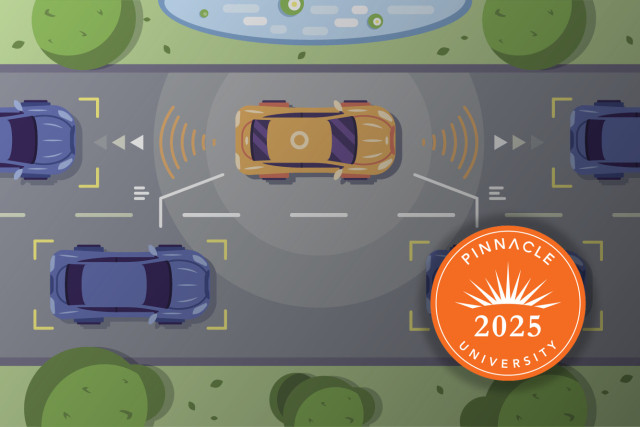
Illinois and Wisconsin Prepare Legislation for Future Fully Autonomous Vehicles
This blog was researched and written by participants in Pinnacle’s 2025 Pinnacle University development program.
As technology progresses through the testing phases for fully autonomous vehicles, the federal government has left the regulation of automated driving systems and connected autonomous vehicle (CAV) driving systems to the discretion of each state.
CAVs are vehicles that can communicate with other vehicles and road infrastructure to help alert themselves and others of current conditions and hazards. There are four types of communication:
- Vehicle to vehicle (V2V)
- Vehicle to infrastructure (V2I)
- Vehicle to pedestrian (V2P)
- Vehicle to everything (V2X)
An example of V2P communication is a CAV sensing a pedestrian walking in the crosswalk and alerting the driver that a pedestrian is walking through that specific crosswalk. The sharing of information, like pedestrians, helps to deliver a real-time picture of the hazards facing the CAV on the roadway. This technology ideally leads to a safer roadway.
The National Highway Traffic Safety Administration (NHTSA) issues guidance for manufacturers and emphasizes voluntary safety guidance, limited exemptions from current guidance and performance-based safety oversight for vehicles. The NHTSA pushes towards a flexible framework that promotes innovation but has not yet passed binding, comprehensive CAV-specific legislation. The following deep dive into Wisconsin and Illinois approaches to CAV and potential CAV legislation will highlight key differences that impact the ability to succeed in enacting meaningful regulatory measures.
Wisconsin’s Brainstorming for the Future
The State of Wisconsin has a special committee for integrating autonomous vehicles into consumer lives that is not discussed in as much detail in other states. The discussion of CAVs is focused through the Wisconsin Automated Vehicle External Advisory Committee (WAVE). Wisconsin also discusses the assignment of fault for CAVs.
The WAVE is responsible for CAV planning, policy implementation and quantifying CAV impacts on transportation systems. The committee has representatives from various sectors ranging from local, state and federal government representatives to business leaders of CAV sectors. The members meet once or twice a year to discuss the three items the WAVE is responsible for. The members actively provide feedback regarding WAVE’s responsibilities and initiatives to ensure that new opportunities or obstacles do not arise regarding the implementation of CAVs into the consumer’s daily transportation.
The assignment of fault when an autonomous vehicle is involved in an accident is a relatively new space. Unlike many other states, Wisconsin has a section on the DMV website regarding legal status of autonomous vehicles in the event of an accident.
The Wisconsin DMV states, “As with any other vehicle that is operated on the roadway, the operator or owner is responsible for the appropriate and safe operation of the vehicle while driving it. This includes the use of any technology the vehicle is equipped with, any malfunctions of the vehicle, and adherence with current state law and the Rules-of-the-Road.”
This quote seems to shield manufacturers from any liability, and seems to assign liability to the owner or operator. While a brief statement, many of the other states we have researched for autonomous vehicle regulation are silent on commenting on fault of an accident.
Illinois House of Representatives’ Unsuccessful CAV Regulatory Proposals
The state of Illinois has attempted to pass numerous legislative bills to regulate testing and insuring of fully autonomous CAVs, starting with House Bill 791 (HB0791), proposed in 2017. The intention of this bill was to create restrictions prohibiting local governments, including home rule units, from enacting ordinances that would ban the use of autonomous vehicles on their roadways. The bill would have effectively ensured uniformity in CAV regulations across the state, preventing a patchwork of local laws that could hinder the deployment and operation of Avs, and would have centralized CAV regulatory authority at the state level. While this bill did not advance beyond consideration by the Rules Committee in early 2017, there was instead a 2018 amendment to the Illinois Vehicle Code (625 ILCS 5/11-208(e-5)), granting the state exclusive authority over automated vehicle operations on Illinois roads, effectively prohibiting municipalities from imposing their own regulations on CAVs.
In October 2018, then-Governor Bruce Rauner signed an executive order establishing the "Autonomous Illinois" initiative to promote the development, testing and deployment of CAV technologies within the state. Under this initiative, the Illinois Department of Transportation (IDOT) was tasked with leading the "Autonomous Illinois" program and collaborating with state agencies to:
- Review CAV research and best practices
- Evaluate and address legal and regulatory barriers
- Develop data-sharing and privacy frameworks
- Assess infrastructure needs for CAV deployment
While the executive order did spur collaboration between Illinois transportation regulators and researchers, the IDOT web portal for “Autonomous Illinois” has since been deactivated and is no longer in operation.
The following year, House Bill 2575 (HB2575) was introduced with a far broader scope of proposed regulation than HB0791. The bill included insurance requirements for testers, a liability framework, preemption of local authority, and explicit authorization of level 4 and level 5 CAVs for operation on Illinois highways, regardless of whether a human operator is physically present in the vehicle. Again, this HB2575 was referred to the House Rules Committee but ultimately did not advance any further.
The Illinois legislature’s next attempt in 2023 was House Bill 2913 (HB2913) that included similar regulations as the previous two bills, with additional stipulations regarding safety, data reporting, applications and approval for manufacturer testing of CAVs, and penalties for non-compliance. Under HB2913, manufacturers could initiate a Safe Autonomous Vehicle (SAVE) project by notifying the Secretary of State, self-certifying compliance, and defining the geographical boundaries of their SAVE projects. Once granted approval, these manufacturers would be required to maintain incident records and provide periodic summaries to both the Secretary of State and the NHTSA. The bill also laid out penalties for non-compliance if a manufacturer failed to meet requirements of the project, up to and including a fine of $10,000 or Class A Misdemeanor charges. HB2913 ultimately met the same end as the previous legislative attempts; the bill did not advance beyond the committee stage and failed to pass before the legislative session concluded on January 7, 2025.
Both Illinois and Wisconsin demonstrate that different approaches can be taken in transitioning to life with autonomous vehicles. Illinois takes a more direct approach than Wisconsin, but both states are considering the impacts of autonomous vehicles on its residents. As CAV manufacturing and technology evolves, Wisconsin seems ready for further discussion while Illinois could draft another bill. Either way, both states are actively monitoring the continuous development of CAVs.



